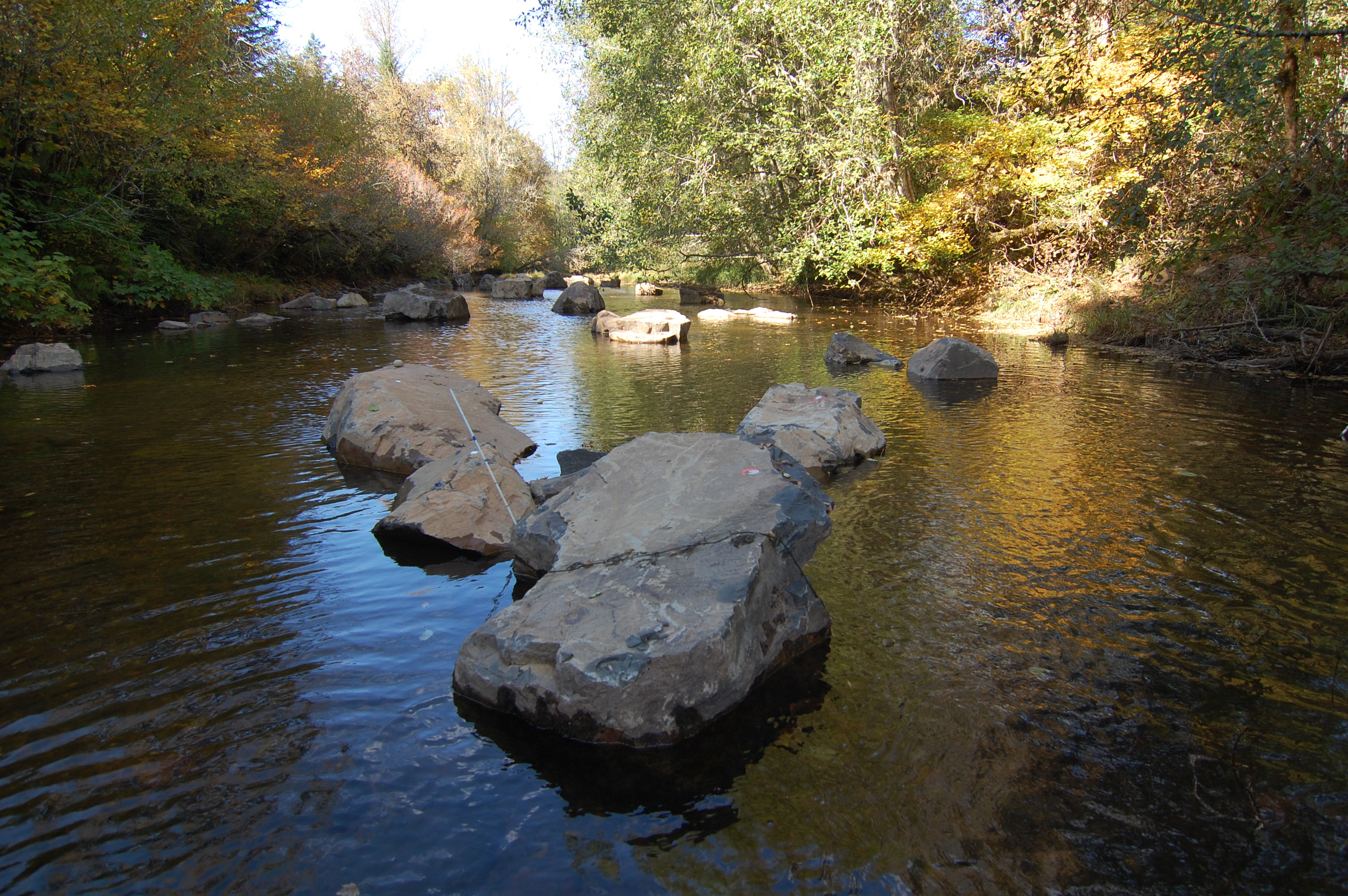Boulder Clusters and Rock Riffles

Description
Boulder clusters and rock riffles are part of a category of BMPs known as aquatic habitat structures, or instream improvement structures. Other aquatic habitat structures also include weirs, dikes, random rocks, bank covers, substrate reinstatement, fish passage structures and off-channel ponds and coves (FISRWG 1998). Proper placement of boulder clusters and rock riffles can restore and maintain a stable channel form, thus reducing erosion and preventing sedimentation.
- Boulder clusters are groups of large rocks placed in a stream to improve habitat, and create scour holes and areas of reduced velocity. Placing the boulders in the stream creates eddies or vortices in their wake, which create overhead cover for fish by partially diffusing sunlight. Boulder clusters can also generate scour that cause pockets of deeper water to develop, which adds to the physical diversity of the stream (Fischenich and Seal 1999).
- Rock riffles are designed to mimic a natural pool upstream of the installed riffle. The riffle serves to reduce upstream slope and velocity. The channel is stabilized by the riffle at the point where velocity increases. Rock riffles also improve fish habitat by increasing downstream oxygen levels (LCSMC 2002).
Applicability
These practices primarily apply to stream restoration projects where stream stability and fish habitat improvements are objectives.
- Boulder clusters can be used in most stream habitat types including riffles, runs, flats, glides and open pools, but are most effective in wide, shallow streams with gravel or rubble beds. In deep streams, they can provide cover and improve substrate.
- Rock riffles are generally limited to sites where grade is the main cause of soil erosion (LCSMC. 2002).
Effectiveness
Evaluations of fish habitat improvement projects have shown a high variability in the benefits of instream boulders. This variability is due to differences in fish seeding levels, species and ages of fish, season of year, the design of the project, time since implementation, and sampling method
(Fischenich and Seal 1999). Group placement of boulders is most effective, but individual boulders may be effective in small streams (FISRWG 1998).
Costs
Costs for stream boulders are estimated at about $70 each. A moderately sized project might cost about $2500 to $3000 in materials (2016 costs, updated from MDE, 2000).
Maintenance
Minimal operation and maintenance activities are required for boulder clusters and rock riffles. The rock clusters should be inspected annually to ensure stability. Boulders that have become dislodged and moved need not be relocated unless they are causing stability problems. If the boulders are moving significantly, this may indicate a faulty design, and the boulders should possibly be moved to an area where velocities are lower or replaced with larger boulders that are less likely to become dislodged (Fischenich and Seal 1999).
Design Considerations
- The primary design considerations for boulder clusters are a) the number, configuration, and location of the structures, and b) the size of the boulders needed for stability. The hydraulic impacts of the boulders should also be ascertained when habitat benefits must be quantified or the potential exists for adverse impacts due to increased velocities or water surface elevations.
- The suitability for these practices for fish habitat improvement should be evaluated by a fish biologist knowledgeable in local stream conditions and habitat requirements for the targeted species. The stream should be inspected and existing habitat quantified.
- For boulder clusters, the greatest benefits are realized in streams with average flows exceeding 2 feet per second.
- These practices may promote the formation of bars in streams with a high bed material load.
- Group placements are most desirable. Individual boulder placement might be effective in very small streams.
- Boulders should not be used near banks susceptible to erosion.
- The use of boulder clusters is generally limited to streams with coarse gravel (or larger) substrate. It is not recommended for sand bed streams because the boulders have a tendency to become buried.
- All projects involving structures in waterways, including boulder clusters and rock riffles, should be reviewed for permitting requirements under the Massachusetts Wetlands Protection Act and the Chapter 91 Waterways permit program.
References
Fischenich, C., and Seal, R. 1999. Boulder Clusters. U.S. Army Engineer Research and Development Center, Vicksburg, MS.
FISRWG. 1998. Stream Corridor Restoration: Principles, Processes, and Practices. Federal Interagency Stream Restoration Working Group,
Kelly, F. 2001. Restoration of Urban Streams. United States Department of Agriculture,
MDE. 2000. Maryland’s Waterway Construction Guidelines. The Maryland Department of the Environment Water Management Administration.
Rutherfurd, I. D., K. Jerie and N. Marsh. 2000. A Rehabilitation Manual for Australian Streams. Land and Water Resources Research and Development Corporation, Cooperative Research Centre for Catchment Hydrology, Canberra ACT, Australia.
LCSMC. 2002. Streambank and Shoreline Protection Manual. Lake County (Illinois) Stormwater Management Commission and USDA-NRCS.
Recommended Fact Sheets and Resources
Heaton, M. G., R. Grillmayer and J. G. Imhof. 2002. Ontario’s Stream Rehabilitation Manual. Ontario Streams, Belfountain, Ontario.
http://www.ontariostreams.on.ca/
USEPA. Restoration Bi-Weekly Update. United States Environmental Protection Agency, Office of Water. Accessed 7/03/02.
http://www.epa.gov/owow/wetlands/restore/update/